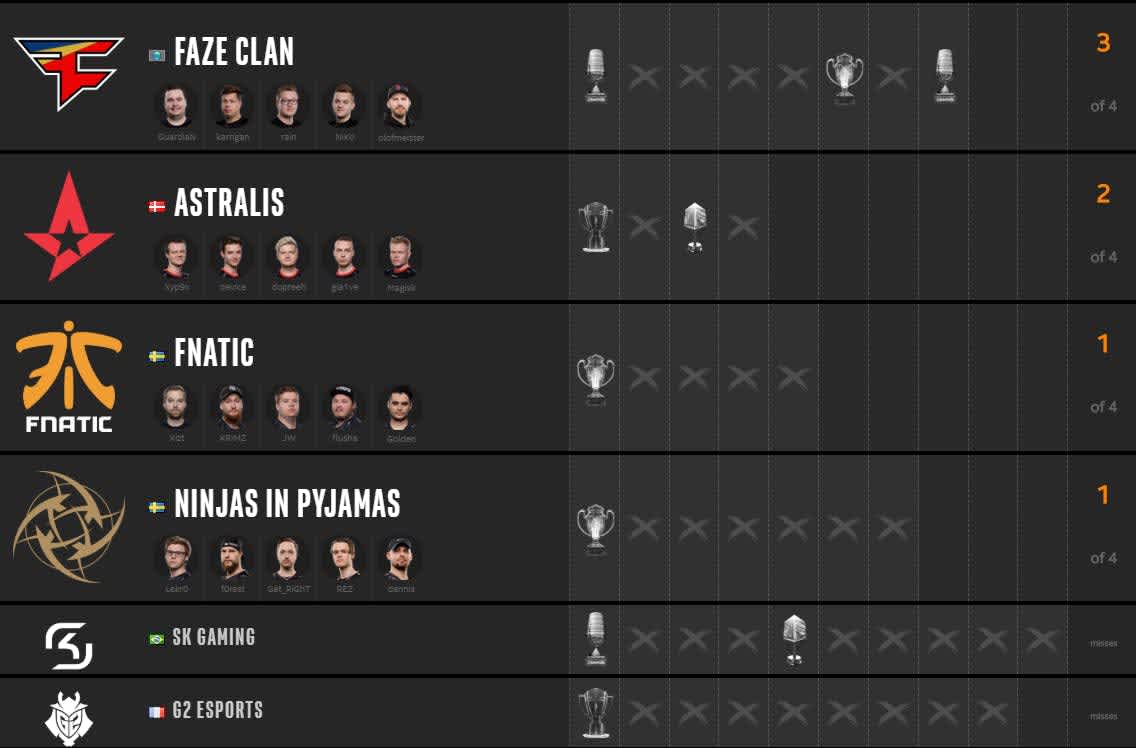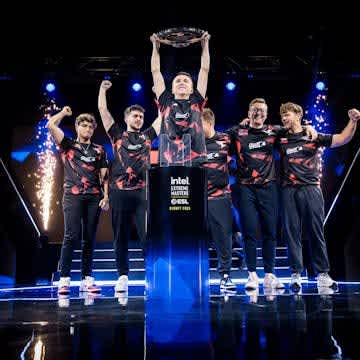Six Things We’ve Learned From ESL One: Belo Horizonte 2018
Another ESL One event is out of the way and we are once again a little bit closer to figuring out the lay of the land in the professional CS:GO scene. It was certainly an odd tournament with only eight participants and both top dogs featuring a modified line-up by necessity. How did they stack up against each other – and what about the massive star-shaped shadow of Astralis over the field?
The devil is in the details: just look at the qualifiers
I’m not against handing out invitations for branding purposes or to increase the odds that the fans in the arena get to cheer for a local team (more on that later), but a closer analysis shows that essentially all eight participants got to Belo Horizonte on the back of some sort of invite: all of the top four finishers got fast-tracked to the tournament while the remaining teams also received direct entry to the closed qualifiers. Don’t get me wrong: I’m not trying to imply that the others were perhaps more deserving, just keep in mind that this little rumble was nothing like the ECS finals, at least in terms of the work that needed to be done in order to get on the stage.
Digging slightly deeper into the list of participants, we can find a few other subtle clues about the scene: Quantum Bellator Fire’s shocking Legend spot at Boston seems to be an obvious fluke judging by their recent results, and they also didn’t exactly light the world on fire as part of this event, going out in a double-elimination system without picking up a single map despite getting an invite straight into the European closed qualifier. The North American one gave us a glimpse of the interesting Bravado Gaming project: the South African team has relocated to the US at the beginning of this year to pick up more experience. Their only notable top-tier appearance to date was at Dreamhack Winter 2014 due to a direct invite: it seems like they still have a long way to go.
No one could withstand the stand-ins
On paper, it might be surprising that the two teams without their full rosters duked it out in the grand final, it is more of a testament of the gulf between them and the other attendants than the sign of anything else. As impressive as cromen and n0thing’s performances were under the circumstances – while the American got most of the coverage due to his name recognition, it’s definitely worth highlighting that the Norwegian finished the whole event as the seventh-highest rated player according to HLTV –, it is nevertheless a great indictment of the rest of the field that two teams with incomplete rosters got to play the final without really breaking a sweat.
Then again, not many of the other teams were ready to compete either. BIG also had a recent roster change to adjust to – and giving a good go in both their matches against a formidable Liquid lineup was slightly better than what was perhaps initially expected of them. The ex-Torqued team’s acquisition by Ghost Gaming was a last-minute development too as they came on board only three days before the beginning of the tournament. Looking at it this way, the performances of the more “stable” invitees has got to be even more of a letdown.
SK’s performance was even more disappointing than it seemed
Finishing 3rd-4th in an eight-team event that was essentially an invitational in front of your home crowd has got to sting. SK’s internal turmoil surrounding their inevitable org change is well-documented, just like their issues with integrating a non-Brazilian player for the first time, an issue which has led to the IGL role’s unthinkable switcheroo in a lineup that was fabled for FalleN’s excellent leadership for so long. Supposedly, they are also looking into bringing in a coach at this point – which seems like a necessary move judging by their recent performances.
Make no mistake, a change is long overdue and it is very difficult to find any redeeming qualities of their showing at Belo Horizonte: you can call Space Soldiers a bogey team as long as you would like, the fact of the matter is that it took them two tries to get past lower-tier opposition in a best-of-three and then bombed out against mouz without even putting up a fight on their own map choice, losing 16-7 on Dust 2 and then crumbling on the T side of Train. Liquid at least managed to take a map off of Faze Clan: SK never even got the chance to do so, despite the borderline extreme backing by the audience.
No library, no party?
Teams playing off the crowd always creates an interesting dynamic which can also add a little spice to the proceedings when they are clearly behind one of the participants. There’s certainly an argument to be made about the unfair nature of tells generated by the enthusiastic supporters – and whether or not the examples of Dota 2 LANs and other games could serve as an example to remove such a phenomenon – but having such a dynamic as part of offline events isn’t necessarily an issue in and of itself.
This particular situation was more problematic though. Even if the crowd favors one team, they usually don’t go dead silent every time their buddies aren’t dominating the game. Even North American audiences managed to create a decent atmosphere at the last two ELEAGUE majors with both pro-VP and pro-Astralis chants occasionally ringing out in the theatre in the final or by giving incredible support to Cloud9 the last time around but still applauding the more impressive moves by Faze. The audience at the Mineirinho Arena were only creating ample schadenfreude rather than a memorable environment. In the end, they couldn’t stop mousesports – though you could make a good argument that they once again shot themselves in the foot when it came to the final.
Mousesports: so close yet so far?
Again, if you accept that the level of competition at this tournament was fairly low, a grand final appearance by mouz was probably the bare minimum you could expect, even with a stand-in issue that seemed to come out of nowhere only eight days before the event. There was quite the chatter about the inclusion of n0thing and his potential impact on the team’s supposedly shaky mental state when the going gets tough: and while I’m certainly not a big fan of such narrative, their complete collapse on Inferno after throwing away a very favorable round on the T side was jarring to watch.
Dig a little deeper, however, and the surface-level argument quickly falls apart. The same team mounted a comeback from 0-11 on Cache that even the ever-winning Fnatic lineup would have been proud of, and if you’re going to give the same “choker” tag to Faze Clan as well with their regular deep runs in so many tournaments, the whole notion of “mental strength” is quickly starting to lose any meaning. If anything, looking at the inverse of this argument reveals so much more about the team: both the firepower and the tactics are in place for mouz, so what else could they need to click? Trust me, if the answer was this straightforward, they would already be up there alongside Astralis.
The Grand Slam makes it all work
Much was made of the exciting fact that four simultaneous LAN events were happening at the time of the tournament in Belo Horizonte. The scattered viewership (plus the depression effect of the World Cup on the eyeballs attracted by esports) numbers are an obvious negative, but it is otherwise a shining beacon of the strength and depth in the CS:GO scene.
It does, however, make it a lot more difficult to actually have an indisputable top dog for a long time. Astralis have opted for an almost Federer-like strategy of picking and choosing their battles, which would normally lead to more arguments about the “real” best team in the scene out of all the tournament winners. But when they do play, the victories are so convincing, the inflicted defeats are so crushing that there is little room for argument. Still, it’s worth mentioning that the early periods of SK’s domination was also marred by the repeated concerns over the disrupted nature of their top-tier opposition – with, in an interesting parallel, olofmeister’s absence being a key factor in the diminished strength of both Fnatic and now Faze Clan.

With only two majors per year that are marred by a high-variance format – just look at the last two winners –, the Intel Grand Slam seems more and more like a masterstroke. Not only does it guarantee that there will be a lot more to play for in the upcoming ESL and DreamHack events (quite literally), it also adds relevance for the previous results of the year. A few years ago, when almost every top-tier team was able to compete in all the major events, this sort of continuity was self-evident. Now, its artificial creation by Intel will add a lot of flair to the proceedings.
It also makes it easier to categorize an oddball quasi-invitational event like Belo Horizonte: if you treat the latest ESL One event as an appetizer for Cologne, it did a perfectly reasonable job. July 3rd is just around the corner after all…






